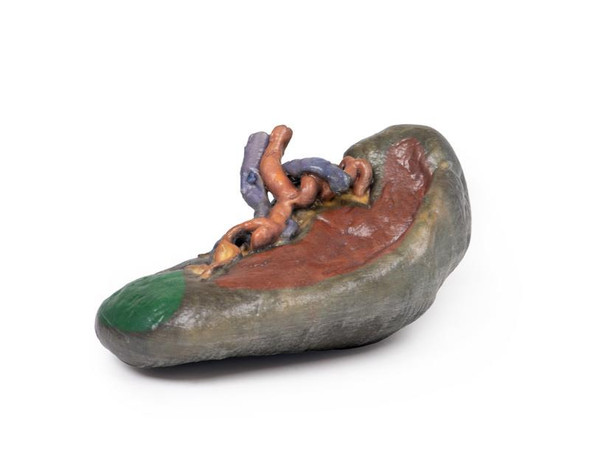Description
Clinical History
A 63-year old male presented to the emergency departed with acute abdominal pain. He has been unable to pass urine for 5 days. Further questioning revealed a 2-year history of urinary frequency, double void, urinary hesitancy, nocturia and a poor urine stream. Abdominal examination showed a tender distended bladder and an enlarged palpable prostate on digital rectal examination. A bedside bladder scan demonstrated a volume of >1L in the bladder. Blood tests shows a severe acute kidney injury. He is diagnosed with acute renal failure due to acute urinary retention. There were multiple failed attempts at catheterizing the patient via the urethra and suprapublically. A total prostatectomy was performed and he made a good recovery.
Pathology
The specimen is an enlarged prostate gland sliced transversely to display the external and cut surfaces, On the cut surface there are numerous nodules varying in size from 2-10mm in diameter. This is an example of benign nodular hyperplasia (BPH) of the prostate gland.
Note
Benign prostatic hyperplasia (BPH) or nodular hyperplasia of the prostate is a common disease in older men. BPH is caused by nodular hyperplasia of prostatic stromal and glandular epithelial cells primarily in the periurethral prostate. Hyperplasia is a result of accumulation of senescent cells due to impaired cell death and cell proliferation driven by androgens, mainly dihydrotestosterone. Disproportionate enlargement of the median lobe is a common feature of nodular hyperplasia of the prostate. The projecting median lobe may occlude the internal urethral orifice on contraction of the bladder.
Prevalence of BPH increases significantly with age. BPH is present in 20% of males at 40 years of age, 70% of males of 60 year of age and almost 90% of males by the age of 80. There is an increased risk of BPH in men with a positive family history of BPH, in obese males and exposure to exogenous androgenic-anabolic steroids.
Clinical presentation of BPH results from urinary obstructive symptoms. Patients complain of urinary frequency, nocturia, urinary hesitancy, double voiding, poor urinary stream and overflow dribbling. Acute urinary retention may result from complete urinary tract obstruction as in the case discussed above. Post void residual urine results from the obstructing prostate which leads to an increased risk of urinary tract infections.
Diagnosis can be made on clinical history and physical examination of the prostate with a digital rectal exam. Prostate specific antigen may be used to screen for prostate cancer. Ultrasound scan or CT can be used to evaluate the volume of the prostate. Treatment of BPH can be treated medically with Alpha-blockers to relax the prostate smooth muscle tone or 5-alpha-reductase inhibitors, which inhibit synthesis of dihydrotesterone. The main surgical treatment for severe cases of BPH is transurethral resection of the prostate (TURP). Total prostatectomy is no longer used due to risk of disabling complications.
Advantages
- Anatomically accurate and identical to real specimen
- No ethical issues - not real human body parts
- Reasonably priced
- Available within a short lead time
- Reproducible, several identical prints can be used as a classroom set
- Can be produced in different sizes to cater for the needs of the teacher
Human Cadavers
- Access to cadavers can be problematic. Many countries cannot access cadavers for cultural and religious reasons
- Cadavers cost a lot money
- High cost for establishing your own plastination suite
- Wet specimens cannot be used in uncertified labs
- Dissection of cadavers is a lot of staff time and that is a cost
- Storage of cadaver material needs special refrigeration etc. which has coast
- If you want another specimen you have to start all over again
Plastinates
- Costs
- Ethical issues
- Timeframe for plastination process
- Many countries do not allow their importation
- One of a kind
Superior 3D print results compared with conventional methods
- Vibrant color offering with 10 million colors
- UV-curable inkjet printing
- High quality 3D printing that can create products that are delicate, extremely precise and incredibly realistic
Clear Support Material
- To avoid breakage of fragile, thin, and delicate arteries, veins or vessels, a clear support material is printed on such spots. This makes the models robust and can be handled by students easily.

















